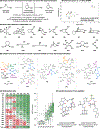Generality-oriented optimization of enantioselective aminoxyl radical catalysis
- PMID: 37200427
- PMCID: PMC10277815
- DOI: 10.1126/science.adf6177
Generality-oriented optimization of enantioselective aminoxyl radical catalysis
Abstract
Catalytic enantioselective methods that are generally applicable to a broad range of substrates are rare. We report a strategy for the oxidative desymmetrization of meso-diols predicated on a nontraditional catalyst optimization protocol by using a panel of screening substrates rather than a singular model substrate. Critical to this approach was rational modulation of a peptide sequence in the catalyst incorporating a distinct aminoxyl-based active residue. A general catalyst emerged, providing high selectivity in the delivery of enantioenriched lactones across a broad range of diols, while also achieving up to ~100,000 turnovers.
Conflict of interest statement
Figures




References
-
- Yoon TP, Jacobsen EN, Privileged Chiral Catalysts. Science 299, 1691–1693 (2003). - PubMed
-
- Jacobsen EN, Pfaltz A, Yamamoto H, Comprehensive Asymmetric Catalysis (Springer, 1999), vol. I to III.
-
- Gao X, Kagan HB, One-pot multi-substrate screening in asymmetric catalysis. Chirality 10, 120–124 (1998).
Grants and funding
LinkOut - more resources
Full Text Sources

